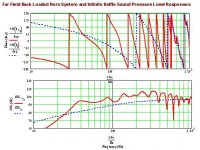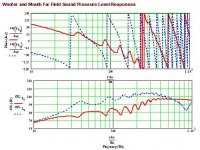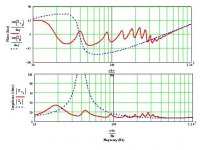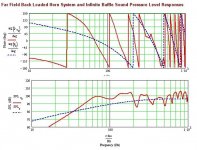After this I give up
http://www.diy-systems.com/wwwboard/forum_entry.php?id=9586
This seems to work they must have made an abrieviation of some kind on the post. I tried this address and it works. Regards Moray James.
http://www.diy-systems.com/wwwboard/forum_entry.php?id=9586
This seems to work they must have made an abrieviation of some kind on the post. I tried this address and it works. Regards Moray James.
Thanks!!
I already downloaded the plans in a few hours ago.
I don't know whats going on the Net, but I almost lost in the wirtual space..... )
)
Maybe I will try the Singular, but first I am looking for a "true" BLH speaker with ca. 40Hz linear response.
Thanks and Greets:
Tyimo
I already downloaded the plans in a few hours ago.
I don't know whats going on the Net, but I almost lost in the wirtual space.....
Maybe I will try the Singular, but first I am looking for a "true" BLH speaker with ca. 40Hz linear response.
Thanks and Greets:
Tyimo
Tyimo said:Hi!
Scottmoose! I belive in the Hedlund and I would like to make some simulation with MJK's software too. In another thread I already asked about the Hedlund's correct measurements, but I will ask here too:
-what is the correct St (3x23cm?)
-what is the correct Sm (65x23cm?)
-what is the correct line lenght?
-what is the horn contour? exponential?
Tyimo
I'll have to dig the data out -its on an old hard-disk that's not in my PC at the moment, but I'll post it in a day or two. It might be a little off, but it'll provide a rough starting point / guide.
Scott
psst...............wanna see my Dallas?
http://fullrangedriver.com/gallery/albums/userpics/10017/Dhorn8.JPG
http://fullrangedriver.com/gallery/albums/userpics/10017/Dhorn8.JPG
BLH design
Have you looked ar this back loaded horn design by Onur Ilkorur? Excellent fo Fostex Fe206e or AER etc.
http://www.yildiz.edu.tr/~ilkorur/speaker/fostex_fe206e.htm
Regards Moray James.
Have you looked ar this back loaded horn design by Onur Ilkorur? Excellent fo Fostex Fe206e or AER etc.
http://www.yildiz.edu.tr/~ilkorur/speaker/fostex_fe206e.htm
Regards Moray James.
Tyimo said:Hi Scott!
Can you find the data???
I have already the original Hedlunds plan, but I don't know what is the real horn line lenght?
Tyimo
Blast! Sorry, I forgot. Will dig it out -expect a post later today. I need to dig some gen. off that old hard drive anyway for my thesis.
Cheers
Scott
Right, found it (at last!).
At the time I did this, I was using Martin's MathCad worksheets to compare the results different horn desings would give using the same driver, in this case the good old Fostex FE206E. Whilst the Hedlund was designed for Lowther drivers, the Fostex specifications are usually relatively close to Lowthers, and I didn't want to introduce another variable (i.e. different driver types) into the comparison. As you can see, the response curve using the 206 isn't too bad. There's a fair bit of ripple, but nowhere near as much as some designs I've seen (and would rather not!) -the Jerrico, and several of the Fostex Factory designs spring to mind as immediate examples. Besides, horns are not known for an overly even response curve!
Approximate dimensions used were: Horn length 129"; mouth area 6.8Sd, throat area 0.25Sd. These were roughly calculated from Jan Hedlund's original drawings -certainly not exact, but they'll be near enough to give a general idea as to what's going on.
With, say, a DX3, I'd expect much the same cut-off point, (or perhaps a little higher) but higher spls below 100Hz -probably dropping somewhat around this point, then levelling off. If I'm correct in guessing this, then the 206 might well be a better match, as it's resonse falls away, but probably in step with room gain.
Hope some of this is useful
Best
Scott
At the time I did this, I was using Martin's MathCad worksheets to compare the results different horn desings would give using the same driver, in this case the good old Fostex FE206E. Whilst the Hedlund was designed for Lowther drivers, the Fostex specifications are usually relatively close to Lowthers, and I didn't want to introduce another variable (i.e. different driver types) into the comparison. As you can see, the response curve using the 206 isn't too bad. There's a fair bit of ripple, but nowhere near as much as some designs I've seen (and would rather not!) -the Jerrico, and several of the Fostex Factory designs spring to mind as immediate examples. Besides, horns are not known for an overly even response curve!
Approximate dimensions used were: Horn length 129"; mouth area 6.8Sd, throat area 0.25Sd. These were roughly calculated from Jan Hedlund's original drawings -certainly not exact, but they'll be near enough to give a general idea as to what's going on.
With, say, a DX3, I'd expect much the same cut-off point, (or perhaps a little higher) but higher spls below 100Hz -probably dropping somewhat around this point, then levelling off. If I'm correct in guessing this, then the 206 might well be a better match, as it's resonse falls away, but probably in step with room gain.
Hope some of this is useful
Best
Scott
Attachments
Scott,
Looking at your calculated response curve shows me that the Hedlund horn is really more of a transmission line then a horn. Once you add the baffle step loss, say -3 dB below 200 Hz, the in room response is going to exhibit very weak bass. But I do agree with your assessment that this is one of the smoother back loaded horn response plots, that matches the observations I have obtained after analyzing many other back loaded horns. I have not looked closely at the Hedlund horn but analyzed the others you have mentioned.
Looking at your calculated response curve shows me that the Hedlund horn is really more of a transmission line then a horn. Once you add the baffle step loss, say -3 dB below 200 Hz, the in room response is going to exhibit very weak bass. But I do agree with your assessment that this is one of the smoother back loaded horn response plots, that matches the observations I have obtained after analyzing many other back loaded horns. I have not looked closely at the Hedlund horn but analyzed the others you have mentioned.
Thanks a lot Scott!!
I will do my own simulations with my drivers too.
Is there any body who already listened the Hedlund???
Moray James: Thanks! I know that loudspeaker of Onur Ilkorur.
Martin: Could you post here some of your sinulations from the "40hZ competitors" For example the Fostex 166ES-R and Nagaoka D-37 cabinets?
Thanks and greets:
Tyimo
I will do my own simulations with my drivers too.
Is there any body who already listened the Hedlund???
Moray James: Thanks! I know that loudspeaker of Onur Ilkorur.
Martin: Could you post here some of your sinulations from the "40hZ competitors" For example the Fostex 166ES-R and Nagaoka D-37 cabinets?
Thanks and greets:
Tyimo
Wow, I never back-engineered BLHs but where dissapointed by everything I could simulate.
I gave up this because it lead me to uneven responses, but looking at the Hedlund's simulated response, I think it may be possible to do something better.
I have simulated horns for Supravox and Fostex drivers, though not so big as 8", and I obtained better plots in "not too big" enclosures.
May I suggest a parameter in MJK's worksheets that is often neglected ? : the impulse response ! Always take care to make it the cleanest possible, and I doubt any horn on the market has this, because it seems to variate with minor modifications. Horns seem to emit a double pulse that gives the horn this "punch", and also adding coloration I think.
I gave up this because it lead me to uneven responses, but looking at the Hedlund's simulated response, I think it may be possible to do something better.
I have simulated horns for Supravox and Fostex drivers, though not so big as 8", and I obtained better plots in "not too big" enclosures.
May I suggest a parameter in MJK's worksheets that is often neglected ? : the impulse response ! Always take care to make it the cleanest possible, and I doubt any horn on the market has this, because it seems to variate with minor modifications. Horns seem to emit a double pulse that gives the horn this "punch", and also adding coloration I think.
MJK said:Scott,
Looking at your calculated response curve shows me that the Hedlund horn is really more of a transmission line then a horn. Once you add the baffle step loss, say -3 dB below 200 Hz, the in room response is going to exhibit very weak bass. But I do agree with your assessment that this is one of the smoother back loaded horn response plots, that matches the observations I have obtained after analyzing many other back loaded horns. I have not looked closely at the Hedlund horn but analyzed the others you have mentioned.
Good point Martin -I'd forgotten about the baffle-step loss. Curses. Some form of correction is going be needed to get the best from it -ram them into the room corners too do you reckon?Agreed that like almost all other BLH designs you see it's more of a TL. This is the best / smoothest I've simulated, so credit where credit's due I suppose, but it's still only good in relative terms. I was building a horn myself for the FE103E, and I eventually gave up. I can get better results, or results that suit me better at least from other designs -ML transmission lines, and the open-baffles I'm now fooling with. On the up side, I suspect the Hedlund might have less in the way of horn-colouration than some, and it's quite an elegant thing, so there's room for all I suppose!
Cheers
Scott
Scott!
I am afraid that your Hedlund simulations is not perfect, because you calculated wrong the hornlenght: 129" (327cm) is too long! You calculated only with the outside pathlength.
I think we have to calculate the correct acoustic length:
SQRT(inside pathlength x outside pathlength).
So we get ca.270 cm!
What do you think?
Tyimo
I am afraid that your Hedlund simulations is not perfect, because you calculated wrong the hornlenght: 129" (327cm) is too long! You calculated only with the outside pathlength.
I think we have to calculate the correct acoustic length:
SQRT(inside pathlength x outside pathlength).
So we get ca.270 cm!
What do you think?
Tyimo
Tyimo said:Scott!
I am afraid that your Hedlund simulations is not perfect, because you calculated wrong the hornlenght: 129" (327cm) is too long! You calculated only with the outside pathlength.
I think we have to calculate the correct acoustic length:
SQRT(inside pathlength x outside pathlength).
So we get ca.270 cm!
What do you think?
Tyimo
Yes, I know. I didn't use the outside pathlength as it happens -I simply took an approximate measure of the horn path's centre-line when I was working up data for a MathCad sim. 2.7m you say? I won't dispute it, you've obviously spent a lot more time that I did on measuring it! Clearly my approximatewas very approximate! 2.7m sounds fair enough, though I doubt it'd have a great deal of effect on the response curve -I'll stuff it back into MathCad shortly to investigate.
Cheers
Scott
And here's my model of the Hedlund with a 2.7m horn length, keeping all the other approximate dimensions I used the same, and still assuming the FE206E. Remember, I wasn't trying for 100% accuracy -just for a rough guide / curve that shows what might be expected from a design and if it's good enough to pursue. On this basis, I would say that, if you want this sort of cabinet / type of speaker, this is still the best I've simulated, and is probably worth building.
Looking at the response curve, the cut-off point's shifted upward to circa 70Hz, and some of the ripple has smoothed out, bar one dip that has increased. To me it looks as if the earlier graph has been trunkated somewhat. I don't expect this model to be overly accurate either, but it will be close enough to show that the Hedlund is not a bad design for what it is compared to the majority of other 'horns' that are out there, and I have to admit, I do think the cab. and the folding geometry is rather elegant. With Lowthers it'll probably smooth out some more -after all, it was designed for those. I might try one last thing with it, just to see if it works -I'll let you know what later on.
Best
Scott
Looking at the response curve, the cut-off point's shifted upward to circa 70Hz, and some of the ripple has smoothed out, bar one dip that has increased. To me it looks as if the earlier graph has been trunkated somewhat. I don't expect this model to be overly accurate either, but it will be close enough to show that the Hedlund is not a bad design for what it is compared to the majority of other 'horns' that are out there, and I have to admit, I do think the cab. and the folding geometry is rather elegant. With Lowthers it'll probably smooth out some more -after all, it was designed for those. I might try one last thing with it, just to see if it works -I'll let you know what later on.
Best
Scott
Attachments
Hi Scott!
You are fast!!!
This result looks like more BLH type than your last.
I think now you are very close to the original one's response.
I like the cab. and this kind of folding geometry too!!
I am very interesting to compare the Hedlund to another, for example to the one of the Fostex recommended enclosure....
I will try tomorrow my simulations....
Greets:
Tyimo
You are fast!!!
This result looks like more BLH type than your last.
I think now you are very close to the original one's response.
I like the cab. and this kind of folding geometry too!!
I am very interesting to compare the Hedlund to another, for example to the one of the Fostex recommended enclosure....
I will try tomorrow my simulations....
Greets:
Tyimo
MJK said:Scott,
...observations I have obtained after analyzing many other back loaded horns
Hi Martin
Any chance you have comments / observations on the following BLHs?
REPLIKON
TANNOY WESTMINSTER ROYAL
I thank you in advance for anything you might be willing to share...
- Status
- This old topic is closed. If you want to reopen this topic, contact a moderator using the "Report Post" button.
- Home
- Loudspeakers
- Full Range
- Which BLH for linear response down to 40Hz?



